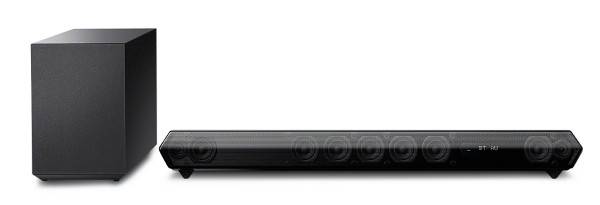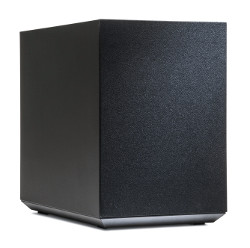Sony HT-ST5 Soundbar System Page 2

Menu-accessible options include Dynamic Range Control, Lip Sync, Dual Mono, a volume leveler called Advanced Auto Volume, and the bass-boosting HEQ (Harmonics EQualizer), which works with Bluetooth or analog inputs in the Sound Field’s Music setting.
The HT-ST5 deploys its drivers just as the HT-ST7 did. The Movie and other surround modes activate all drivers in the bar, while Standard omits a couple, and Music strips down to single woofer/tweeter pairs (making the bar, in effect, a pair of two-way satellite speakers).
Associated equipment included an Oppo BDP-83SE universal disc player and an old iPad 2 for music streaming. I used the latter just long enough to verify that Bluetooth worked as advertised and sounded decent.
More Sparing
My 2013 review of the HT-ST7 complimented the “warm and ingratiating” midrange. While I didn’t have the two products around together for direct comparison, the HT-ST5 seemed to ladle out the honey with a more sparing hand, primarily in the Music mode, which seemed a little more austere than I remembered for the HT-ST7. However, the Movie mode was as sensational as ever, thanks to different voicing and the enrichment of the surround channels. Bass was also top-notch, by soundbar standards, especially in the integration of bar and sub, a weakness of nearly all bar-and-sub sets.
The Frozen Ground (Blu-ray, DTS-HD Master Audio) has Nicolas Cage dramatizing a real-life Alaska State Trooper in a hunt for a serial killer. Even before the movie began, the surround-channel content of the DTS-HD logo presentation got my attention. The disc also includes a DTS Sound Check with test tones, and sure enough, the surround-channel tones sounded closer to emanating from the same locations as real physical surround speakers would than what I’ve heard from most other soundbars, with effects detaching from the bar and approaching the seating position. Fooling around with the Voice modes, I preferred the more natural-sounding Voice 1, though the treble boost of Voice 2 suited a sotto voce hospital scene. In a chase scene with galloping bass and timpani, the bar and sub worked together effectively as a team.
Need for Speed (BD, DTS-HD Master Audio) casts Breaking Bad’s Aaron Paul as a daredevil drag racer. The aggressive motorized noise seemed slightly richer when I shifted from Movie 1 to the more surround-heavy Movie 2. I also resorted again to Voice 2 to enable dialogue to be heard above the testosterone-fueled engines. Had I not been a reviewer pushing the bar to its limits, I would have smoothed out volume levels with the Advanced Auto Volume control.
Inside Llewyn Davis (DVD, Dolby Digital) went to the opposite extreme, focusing my attention on Oscar Isaac’s fragile tenor and graceful acoustic guitar. Here, Voices 2 and 3 made singing and speaking voices too thin and edgy; Voice 1 was the way to go.
 Especially in musical scenes set in folk clubs, the surround processing was satisfyingly rich, nuanced, and yes, even realistic, making the movie that much more affecting. This bar is a truly accomplished movie machine.
Especially in musical scenes set in folk clubs, the surround processing was satisfyingly rich, nuanced, and yes, even realistic, making the movie that much more affecting. This bar is a truly accomplished movie machine.
9 from ’77
A 1977 recording of Beethoven’s Symphony No. 9, with Herbert von Karajan conducting the Berlin Philharmonic, arrived on stereo SACD (converted to high-res PCM for the bar). It was tonally bland and spatially constricted in the Music and Clearaudio+ modes—but Movie 2 sweetened it and opened it up, adding fullness and plusher textures. In fact, I know this is going to sound outlandish, but the effect was not unlike a concert hall. You’ve got to hear it to believe it.
Movie 2 was also the appropriate choice for the lossless 5.1-channel version of King Crimson’s Discipline on DVD-Audio (Music mode being only 2.1 channels). Some instruments are intentionally mixed into the surround channels. Combined with the front channels, they formed a tight, believable soundfield. With Tony Levin on bass guitar, the system’s low-frequency virtuosity was impossible to miss. When he shifted to Chapman stick, the tap-stringed instrument mustered tone color as rich as I’ve heard with this familiar material on any system.
The SACD release of the self-titled album by John Coltrane and Johnny Hartman is a perennial favorite and showed the bar’s Music mode at its best. That mode suited the opulence of Hartman’s baritone; switching to Movie offered no advantage. At one point, I accidentally disconnected the subwoofer; this resulted in an effective A/B comparison of the bar with and without it. Without the sub, Hartman’s voice thinned out noticeably. The sub made it whole—but, notably, without making the deep voice localizable in the sub. This demonstrated not only how much the system needed its sub but also how deftly the sub and bar interwove together (with the sub located up front, close to the bar). In this respect, the HT-ST5 is even better than the HT-ST7. An enterprising sales guy who tries this on the show floor might sell a lot of bars.
Is the Sony HT-ST5 expensive for a soundbar? Yes, but to state the obvious is to miss the point. This bar straddles the psychologically significant $1,000 barrier, while more or less maintaining the performance of the $1,299 model, making this one of the more affordable high-end soundbar systems out there.
Audio editor Mark Fleischmann is also the author of the annually updated book Practical Home Theater (quietriverpress.com).


























































